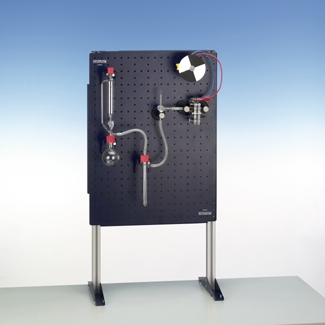Principle
PEM (proton exchange membrane) technology refers to the type of fuel cell favoured by car makers and companies that build combined heat and power plants. The demonstration set-up depicted here produces hydrogen using the classic method by reacting hydrochloric acid with zinc in a gas generator and passing it through distilled water for purification. In the PEM fuel cell, it is then reacted with oxygen (from the air) to produce water and electrical energy directly. That electrical energy produced from the fuel cell is used to drive a small motor. The advantage of the set-up shown here is that neither an external power supply (electrolysis) nor a compressed gas cylinder is required in order to generate the hydrogen. It is possible to produce just as much hydrogen as needed at any time without a great deal of effort.

